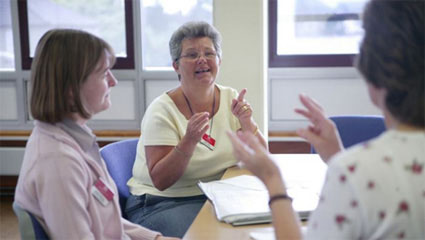A child learns from his surroundings. A child is a very keen observer and listener. The speech develops as a result of this intent observation. Children first start communication with monosyllables and then gradually use two or more words to convey the meaning. Children use the words in relation to the surroundings. The complete sentence formation takes place much later. Read on to know more about the concept of speech.Learning Happens Through Imitation?
It is a general belief that children learn to talk through imitation. This is true to a certain extent. But then we also come across situations where we are stumped by a certain statement or reaction of a child that comes out of the blue. We are sure that they are not imitating anything as they have not witnessed anything like it before. It is a spontaneous reaction for a novel situation. So learning through imitation is not the complete explanation to describe a child’s learning process.
Observers also opine that children do indeed learn to talk through imitation, but this is not by imitating every word in the sentence that they happen to hear around them. They learn by taking note of some important aspects like the verb, the noun or the article. These basically act as structural basis for their sentences when they are trying to express themselves. They fit in words that they like to or feelings that they wish to convey and try to express them verbally. This way they learn to talk. Experts say that this belief is also true but again partially.
How Does Speech Develop?
Things become clearer if you try to notice the manner of development of the child as he learns to talk. There is a whole lot of communication going around the child and the child is particularly observant towards them. He is an intent listener and certain words or expressions that are of interest to them get registered in their mind.
If you study the developmental stages of the child and compare them with that of other children of his age, you will notice that they are more or less at par with each other. Their sense of communication and the manner in which their minds mature are similar at the same age group.
The surprising part in this study is that this pattern of development of expression or the way in which they are gradually learning to speak are the same regardless of the fact whether the child grows up in the company of other children or grows up alone in a completely adult environment.
So How Does this Actually Happen?
As said earlier, children are very aware of the communication that is taking place around them. They try their best sense to make sense of the communication and the various components of that communication. It is a trial and error method that can be best described to explain the manner in which a child learns to speak. As they listen, they register and then use those words, letters or expressions in which ever form they find them convenient to use to speak.
There is also a system of rules that they construct within themselves. This should be misunderstood as a conscious system. This is something that is more of a reaction of their minds that makes them produce sentences that are similar to those that they have heard.
Association is the Rule
There is a pattern to this rule and the manner in which they learn to speak. This is association. They try to associate the objects they try to speak about to the real ones. They try to comprehend the contextual part. This is why you will find your child pulling your apron in the kitchen and say “mummy milk.” You will certainly not find him saying this when you are working in the garage or tending your plants. He has learnt the association of food with kitchen and then related the two and expressed himself.
Children learn speaking by using words that are enough to convey what they want to say. They do not understand the need to use adverbs or prepositions to make a complete subject-predicate sentence. This is why most of your child’s early sentences will have two to three words that are a noun and a verb or a noun and an adjective. The uniformity in order comes as the child finds that he is indeed able to say what he intends to convey.































